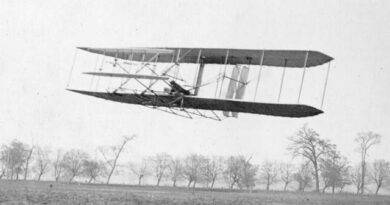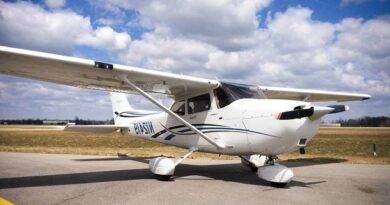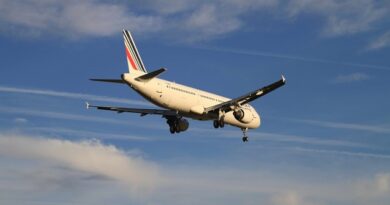What Happens if an Airport Has More Than Three Runways? Naming and Designation Explained
In aviation, runway designation and naming systems play a critical role in maintaining efficient and safe operations. However, as airport infrastructure expands to meet rising demands, some airports require more than three runways to handle air traffic efficiently. This article delves into the implications of having multiple runways, examines how they are designated, and explains the impact on air traffic control and airport functionality.
Why Do Airports Need More Than Three Runways?
Airports with significant passenger and cargo traffic volumes often find that one or two runways are insufficient for handling high volumes of takeoffs and landings. This is particularly true in major metropolitan hubs and in cities experiencing rapid growth. Airports with four, six, or even eight runways can accommodate far more aircraft and reduce delays, especially during peak hours. The following are some reasons an airport may expand beyond three runways:
- Increased Capacity: More runways allow an airport to handle more flights per hour.
- Operational Flexibility: Additional runways provide flexibility for maintenance schedules, allowing runways to be closed temporarily without severely impacting operations.
- Weather Adaptability: Multiple runways oriented in different directions give pilots options during adverse weather conditions, allowing takeoffs and landings with optimal wind alignment.
How Runways Are Designated: The Basics
Each runway has a unique designation based on its alignment with the magnetic compass. For example, a runway aligned north-south would be designated “18” for a southward direction and “36” for a northward direction. This numbering simplifies navigation and communication for pilots and air traffic control (ATC).
- Runway Numbers: Each number corresponds to one-tenth of the magnetic azimuth, rounded to the nearest ten degrees.
- Dual Runways: If two runways are parallel, they are designated with “L” and “R” for left and right.
- Triple Runways: When there are three parallel runways, “L,” “C” (center), and “R” are used.
However, adding a fourth or more runways in parallel requires a different approach.
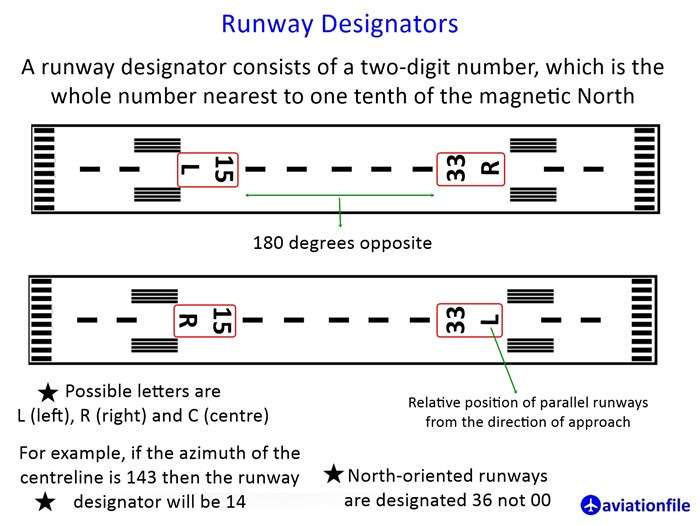
What Happens When There Are More Than Three Runways?
With more than three parallel runways, the existing naming system reaches a limit. To avoid confusion, airports adopt creative methods for designating additional runways. Here are the methods and the challenges associated with them:
1. Repeating Designators by Offsetting Magnetic Directions
When airports have more than three runways oriented in the same direction, they often employ an offset in the magnetic direction by a few degrees. This offset, though minor, allows for re-designating the additional runway numbers without major confusion. For instance, at Los Angeles International Airport (LAX), which has four parallel runways, two runways are designated as 24L and 24R, while the other two are labeled 25L and 25R. This approach helps differentiate each runway without requiring a full renaming system.
2. Adding More Letter Designations (Uncommon)
In cases where more than three runways are present, some airports have considered using additional letters beyond L, C, and R (such as A, B, etc.). However, this system is less common, as it can create additional complexity for pilots, who may struggle to remember and differentiate between less commonly used letter designations. Therefore, most airports avoid this method, instead preferring minor numeric adjustments.
3. Grouping Runways by Distance
In airports with extensive parallel runways, groupings may be employed based on runway proximity. For example, some airports build two pairs of parallel runways with significant distance between the pairs. These are then designated as separate pairs with slight numerical adjustments. This is less common but can be found at some expansive international hubs where land allows for widely spaced parallel runways.
4. Non-Standard Naming Conventions
Some airports, notably outside of the United States, have begun exploring non-standard runway naming conventions. However, such approaches are rare and may create complexities, as they often deviate from the International Civil Aviation Organization (ICAO) and Federal Aviation Administration (FAA) standards. While not widely adopted, non-standard naming is sometimes seen in exceptionally large airports with unique operational needs.
How Do Multiple Runways Affect Air Traffic Control?
With additional runways, air traffic control (ATC) responsibilities become more complex. The ATC system must manage multiple active runways, ensure clear communication with pilots, and coordinate closely with ground operations. Some key aspects ATC must manage include:
- Enhanced Communication Protocols: More runways mean more communication between pilots and controllers, requiring clear and precise language.
- Runway Sequencing and Separation: ATC coordinates takeoffs and landings to maintain safe distances between aircraft. With multiple runways, controllers often sequence flights based on runway availability and wind conditions.
- Advanced Technology Integration: Some large airports implement advanced ground radar and automation systems to assist controllers in managing multiple runways efficiently.
Examples of Airports with More than Three Runways
Several international airports exemplify successful multi-runway systems:
- Los Angeles International Airport (LAX) – LAX has four parallel runways designated as 24L, 24R, 25L, and 25R, using a slight directional offset for differentiation.
- O’Hare International Airport (ORD) – Chicago’s O’Hare has eight runways, some of which are parallel and others cross-aligned, offering operational flexibility.
- Dallas/Fort Worth International Airport (DFW) – With seven runways, DFW uses a combination of parallel and perpendicular orientations, optimizing operations based on weather and traffic.
These airports are some of the busiest in the world, and their runway systems are vital to maintaining high traffic throughput.
Istanbul Airport (LTFM) as a Model for Multi-Runway Systems
Istanbul Airport (LTFM) illustrates advanced runway management for airports with multiple parallel runways. It currently operates five runways, each strategically designated to optimize traffic flow and reduce congestion. These include:
- 16L/34R and 16R/34L: Parallel runways each measuring 3,750 meters, typically supporting both arrivals and departures.
- 17L/35R and 17R/35L: At 4,100 meters each, these runways handle separated operations, with 17L used exclusively for arrivals and 17R designated for departures.
- 18/36: A shorter 3,060-meter runway used for flexible arrival and departure operations.
This configuration allows Istanbul Airport to streamline simultaneous operations, minimizing delays even during peak traffic. Using these specific runway designations and lengths, the airport efficiently manages high volumes of passengers and cargo. This approach positions LTFM as a benchmark for large-scale airport operations, especially for hubs with complex traffic demands.
Sources: PilotNav, VATSIM, DHMI.
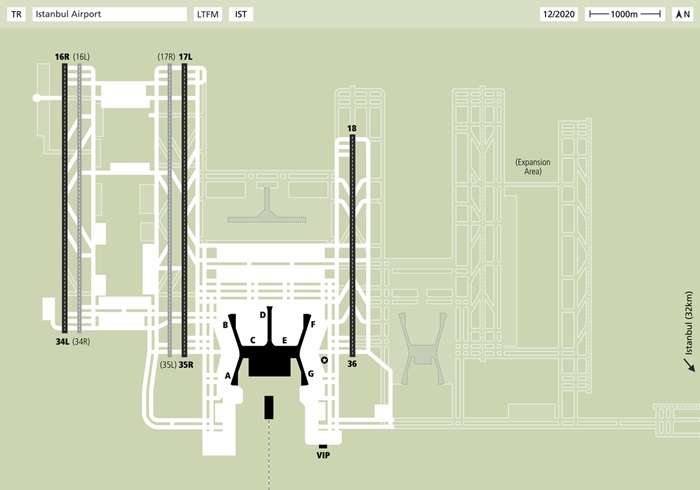
Challenges and Limitations of Multiple Runway Designation
Managing more than three runways introduces several challenges for airport management and aviation authorities:
- Confusion Potential: With multiple designations, there is potential for confusion among pilots, particularly if letter extensions (e.g., “A,” “B”) are used.
- Infrastructure Constraints: Expanding runway systems require significant land and investment, which may be limited in densely populated areas.
- Increased Operational Complexity: More runways mean higher demands on ATC, which can lead to increased training needs and operational costs.
Conclusion
As airports grow to meet increasing air traffic demands, their runway designation systems become more complex. By understanding and utilizing a combination of minor directional offsets and unique designation methods, airports effectively manage multiple parallel runways, balancing safety and efficiency. This approach ensures clear communication between pilots and air traffic controllers, promoting smoother operations at high-traffic airports worldwide.
References and Further Reading
- International Civil Aviation Organization (ICAO). Annex 14 – Aerodromes. ICAO, 2022.
- Federal Aviation Administration (FAA). Air Traffic Control Manual. FAA, 2023.
- Transport Canada. Airport Operations and Runway Management. Government of Canada, 2021.
